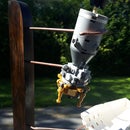Introduction: Quick and Easy Lapstrake Clamps for Boat Builders
When you venture into the world of boat building, you quickly realize that standard woodworking clamps are pretty limited in their functionality. The design of the woodworking clamp incorporates strength and pressure, and while that may be useful when building a cabinet, their shallow clamping depth is a hindrance to the the creation of water craft. That's where the lapstrake clamp comes in. It's designed with longer limbs that allow you to reach around the gunwales of the boat, but at the sacrifice of pressure, which, fortunately for us, isn't a necessity.
This is an instructable on a simple lapstrake clamp that can be knocked out in no time, using scrap material you have on hand, where you can take as much care as you want to make quality clamps, or just whip them out, as I did, so as not to delay my project. That's an important factor when you consider the amount of time that goes into boat building. You don't want to waste a day or two on building the tools to build your boat, when your actual project itself can end up taking you weeks if not months.
I'm using recycled pine from old pallets for mine, which is an unlikely wood to use due to its softness, but because of their simplicity of design, should I break one, I can replace it with three more in under 15 minutes. There's no rule on length. You can make one that's six inches, or 24 inches. It's your choice with the only consideration being the amount of pressure exerted at the clamping end.
Step 1: Tools and Material
Tools;
- Saw - Preferred jig or scroll saw but it can be done a table or hand saw
- Drill and bit
- combination square
Materials;
- wood - 1x3" works best, but you can use whatever you have on hand
- 5" stove bolts with 2 washers and 2 nuts
- 1.5" hex bolt with washer and nut
Step 2: Drawing Out Your Limbs
First you need to cut your wood to length. I ended up creating two types of clamp. One that was 10" that gave me more pressure at the clamping end, and six more that were 16" that gave me the reach I needed.
Next, use your combination square to draw out two lines on each end of your piece, roughly 1.5" apart. Then draw another line down the length that divides your board, roughly, in half.
Step 3: Cutting Out Your Limb
This process is pretty simple. For the inside angle, you're going to need to drill a hole at each corner to allow your jigsaw to make the turn, but all in all it's follow the lines to get your 'C' shape. For safety, you should clamp your board down and cut one end at a time. Now honestly, I started that way, but it was annoying clamping and re-clamping, and I had time constraints, so I just freehand cut them, however I don't recommend doing that.
Step 4: Making the Hinge
This job I did on the table saw, but it can be handled by the jigsaw or by hand saw, and honestly, I didn't even bother to measure what I was removing. I just set the saw guide to half the width of the wood (leaving consideration for the thickness of the blade), and cut through one of the angles of the 'C' till the blade reached just under the top edge of the wood.
Next I used my coping saw to slice off one side of the split, keeping in mind that, as a hinge you need to slice off the opposite side to marry them up.
Step 5: Attaching Your Hardware
The hinge is simple. I used my belt sander to round the ends first, but that's not entirely necessary. If you're in a hurry to get back to your boat building, you can leave them squared. Just set your two ends overlapping at roughly the angle you want them to be, then drill. You can install your hex bolt right away with a washer before the nut, but leave it loose for now.
Once you have your hinge made, you need to make sure your clamping end is flush. We've left the nut loose because we're going to overlap the clamping end, hold them in place and cut straight through them. I did this on the table saw for speed, but again, any saw will do as long as you cut relatively straight. Now, your clamp ends should marry up perfectly, so you can tighten the bold on the hinge.
Finally, You need to drill the hole for the adjustment stove bolt. There's really only one consideration here; The closer to the clamping end, the more force that is exerted, while placing it closer to the hinge end will give you more reach.
When you've measured and drilled your holes, you'll need to ream the hole on one limb wider to allow for play in the bolt so that the jaws can actuate with the bolt in place. I simply drilled several holes in a line, then connected them into a channel using my jigsaw, but again, if your plan is to create a more 'quality' clamp, you can carefully mortise it using chisels and a hammer.
Step 6: The Adjustment Bolt
When your holes are drilled, you can install your adjustment stove bolt. Put it through one limb then tap it down so it 'sets' into the drilled hole. Next, put a washer and nut to lock it to that limb. finally, bring the jaws together with the bolt going through the widened hole and put another nut and washer on the end. You can substitute a wing nut if you want to make your clamp adjustable by hand, otherwise you'll need a wrench to tighten and loosen it.
Step 7: Finished
That's it. They're quick and dirty, but they get the job done without taking away much of your precious building time. Again, the design can be used to create quality clamps that will last a lifetime, to be handed down from generation to generation, or if you're like me, and don't want to waste time, it can be used to make a tool that will speed up the progress of your project, improve its quality, but most of all, won't cost you much time to fabricate.
Again, thanks for checking out my instructables. I hope you find it useful.

Participated in the
Great Outdoors Contest

Participated in the
Pallet Contest

Participated in the
Epilog Challenge VI













